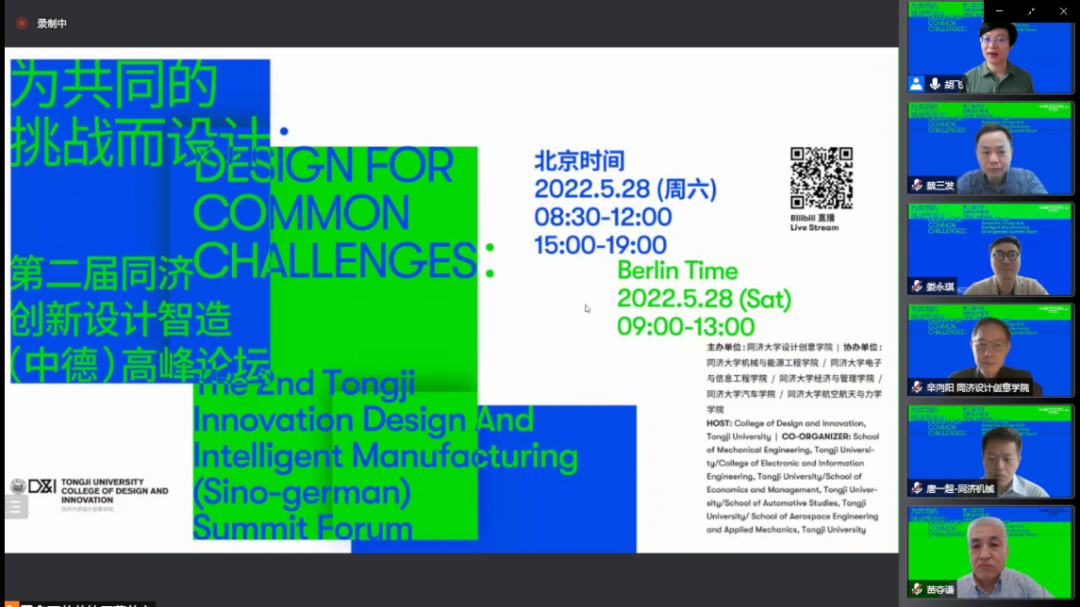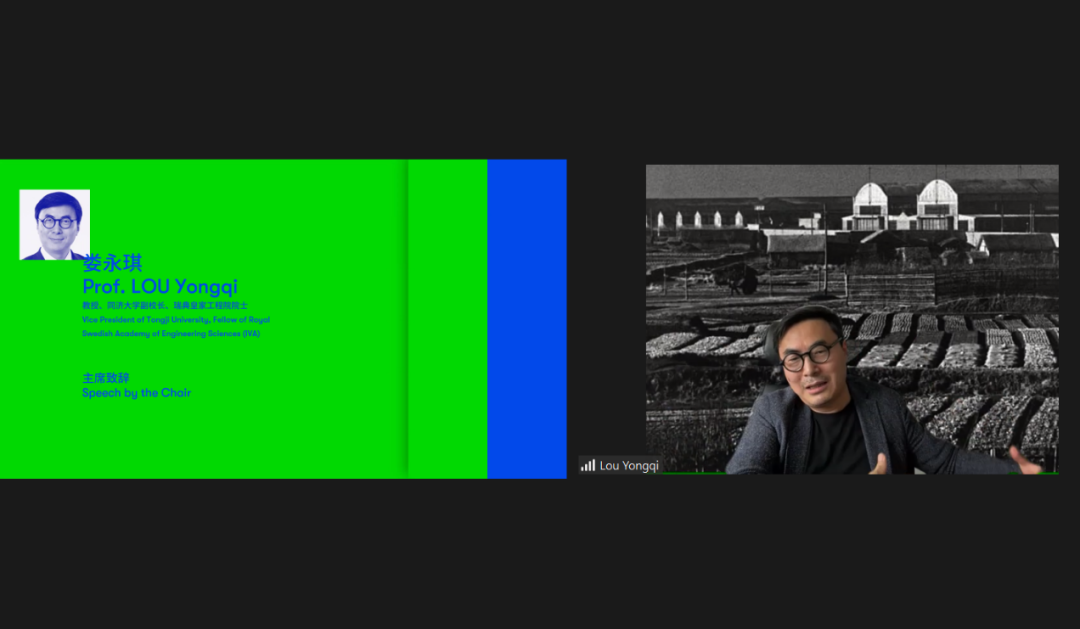The year 2022 marks the 50th anniversary of the establishment of diplomatic relations between China and Germany and the 115th anniversary of the founding of Tongji University. As one of the celebration activities at the university, the Second Tongji Innovative Design and Smart Manufacturing (Sino-German) Forum was held online successfully. A total of 13 Chinese and German experts and scholars from design, public management, computer science and technology, mechanical engineering, and vehicle engineering made keynote speeches on design and manufacturing, design and technology, and design and business. The interdisciplinary presentations on the theme of Designing for Common Challenges attracted as much as 13,000 viewers at peak time.

The forum going on online
The "innovative design and intelligent manufacturing discipline group" of Tongji University initiated the forum which had two sessions of Tongji Innovative Design and Intelligent Manufacturing, and Design For Common Challenges (Sino-German). LOU Yongqi, President of the Forum, member of the Royal Swedish Academy of Engineering Sciences and vice president of Tongji University, attended the opening ceremony of the forum. He delivered a speech, briefing the development of the design discipline of Tongji University. He said that over the past decade, Tongji University had successfully made a strategic transformation towards "innovative design". In the new era, Tongji University is exploring how design can play a greater role, cooperate and integrate with other disciplines, dissolve discipline barriers, and link the development of the discipline group with the problems and challenges faced by this era by building a discipline group of "innovative design and intelligent manufacturing" with interdisciplinary characteristics. It is hoped that this discipline group can become a design innovation engine for the economic and social development of Shanghai, the Yangtze River Delta, and the country.

Vice president LOU Yongqi delivering a speech
XIN Xiangyang, a professor of College of Design and Innovation of Tongji University, made a presentation on "the essence of technology". He introduced the entry points from technology to design, and from design to technological innovation by focusing on academic research and research in the industry, which provided a theoretical perspective for the exploration of the construction and development of the discipline group.
MIAO Shengqian, a professor from College of Electronic and Information Engineering of Tongji University did a presentation on "key technologies of intelligent video surveillance" which was based upon his work on intelligent public security technology means for smart cities. He started from research on accurate pedestrian search algorithm, introduced two algorithm models, namely, two-stage algorithm and end-to-end algorithm, and ended with how to improve the accuracy of search on the existing network architecture.
CHENG Mingwang, a professor at the School of Economics and Management of Tongji University, made a speech on "upgrading and design of manufacturing industry under the impact of the Internet wave". He divided the social development track into three stages by reviewing the Industrial Revolution (1820) and the oil crisis (1972) from the theoretical perspective of economics. He explained the agricultural society, industrial society and post-industrial society in different stages. The human society has experienced corresponding development stages such as "resource-driven, efficiency improvement, and innovation-driven stages".
TANG Yichao, Professor of the School of Mechanical Engineering of Tongji University, shared his research work on bistable rigid soft coupling robot, amphibious flexible climbing robot and high-energy magnetic controlled medical robot on the topic "bionic soft robot design". He designed a variety of soft structures including rigid soft coupling structure, dome-shaped convex structure, and winding muscle structure, and realized reliable applications of this kind of robot structure in real biological interface through mechanical modeling and optimization, robot drive and control based on the underlying mechanism of natural organisms in real physical scenes.
Professor Huang Yanjun from the School of Automotive Studies, Tongji University, spoke on the topic "key technologies and applications of intelligent networked vehicles". He introduced frontier hot issues of the decision-making and control module of central processing system, including how to use mechanism model to enhance the security of artificial intelligence decision-making system, human knowledge to enhance the intelligence of artificial intelligence decision-making control system, domain knowledge to enhance the credibility of artificial intelligence decision-making control system, and how to realize the evolution of performance by closed-loop self-learning of decision-making and control system.
SUN Xiaohua, Professor of College of Design and Innovation of Tongji University, did a presentation on "research on human-machine collaborative intelligence from the perspective of interactive design". According to him, the human-machine interaction has experienced three development stages: "human intelligence", "digital enhanced human intelligence" and "human-machine collaborative intelligence". He also explained how human-computer collaboration could improve and expand human capabilities by quoting examples from such research projects as "AI-based painting intention understanding and creation assistance", "non-common target word retrieval based on circuitous description for aphasia patients" and "remote inspection to support rehabilitation evaluation and training guidance", as well as "designer AI collaborative creativity" and "interpretable HMI in human-computer co driving" for illustrations of human-computer intelligence integration and collaborative work.
Daniel Graff, associate professor of College of Design and Innovation of Tongji University, made a presentation on "when the West meets the East". He started from the Chinese word "design", and explored the differences between the western and Chinese design ideas by explaining the philosophical and cultural background behind this difference, especially the unique Chinese culture and philosophical wisdom contained in the Chinese design perspective. He believed that the Chinese design perspective would greatly enrich the western design concept, and provide more inspiration, which will play an important role in understanding and defining complex problems, developing design research, and innovating design practice.
WU Jie, a professor of College of Design and Innovation of Tongji University, shared her academic experience and research perspective with the title of "design for a real and virtual world". She believed that in view of the common challenges we are faced with the changing characteristics of the times, we should not only design for the real world and the virtual world, but also for the perfect integration and interaction between the real world and the virtual world.
Detlef Zühlke, Professor of Kaiserslautern University of Technology of Germany, spoke on "design paradigm in the era of industry 4.0". He introduced the impact of technological development on industry and design paradigm, and discussed the development law and its enlightenment. He believed that it was important to establish a wide connection between engineering applications and integrated design, and between human beings and technology for the development of the next stage. He called for the establishment of extensive cooperation in dealing with this problem.
FAN Ling, a distinguished researcher from College of Design and Innovation of Tongji University, shared his understanding of artificial intelligence and practical projects over the years on the topic of "machine intelligence and creative design". According to him, artificial intelligence technology should not be simply regarded as machines to replace humans that brings automation to production. He advocated mutual learning and coevolution between machines and humans, and introduced machine learning into design through interdisciplinary cooperation, hoping both of them can become part of each other's system.
Thomas Hoffmann, a professor at Osnabruck University in Germany, made a speech on "linking the world: how to combine academic teaching with industrial projects in design". He introduced how to combine teaching with industrial practice and cooperate with industry in design education, especially in industrial design education, from the perspective of training program design, teaching activity organization, teaching staff, and industrial cooperation. At the same time, we should promote interdisciplinary and international cooperation to help students understand the development of technology and the current situation of the industry faster.
Kurt Mehnert, a professor at the Wangen University of art in Fuchs, Germany, spoke on the topic of "educational challenge of learning and research, complexity of design and comprehensive nature of design practice". He introduced in detail how he combined teaching and research and promoted each other in his years of design education practice, shared his cross-cultural experience of cooperation with China by using specific and vivid cases. He shared his cooperation projects with China in design education, in particular, the specific mode of teacher team cooperation and talent training of both sides.
In his closing speech, the dean of College of Design and Innovation thanked the participants for their participation, and remarked that this forum marked a new beginning of inheriting the tradition of cooperation between Tongji and its counterparts in Germany in expanding cooperation and innovating the form of cooperation in the "Tongji University Design Era" under Tongji University’s strategic framework 2.0 of cooperation with Germany. He hoped that both sides would strengthen cooperation and exchange in the future and meet common challenges through design innovation.